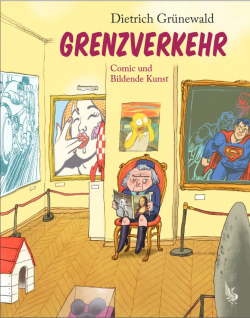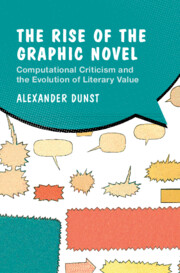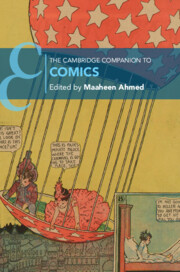Im Monitor werden in unregelmäßigen Abständen aktuelle Publikationen aus den letzten 6 Monaten vorgestellt, die für die Comicforschung relevant sein könnten. Die kurzen Ankündigungstexte dazu stammen von den jeweiligen Verlagsseiten. Haben Sie Anregungen oder Hinweise auf Neuerscheinungen, die übersehen worden sind und hier erwähnt werden sollten? Das Team freut sich über eine Mail an redaktion@comicgesellschaft.de.
→ Zu früheren Monitoren.
Kieler Berichte, Bd. 26
Erik Rading
Universitätsverlag Kiel
August 2023
Verlagsseite
„In den vergangenen Jahren wurden immer wieder Untersuchungen veröffentlicht, die sich der Frage widmeten, ob bestimmte Comics als Bildungsromane verstanden werden können. Trotz vermeintlich naheliegender Anschlusspunkte, z. B. der (literarischen) Auseinandersetzung mit lebensweltlichen Vorstellungen von Bildung, sucht man dabei eine pädagogische Perspektive weitestgehend vergebens. Dieser Leerstelle versucht sich der vorliegende Beitrag anzunehmen, indem er die Übertragung der pädagogischen Elemente des Bildungsromans auf den Comic untersucht. Dabei folgt er der Annahme, dass sich schon im Bildungsroman wie auch im Comic lebensweltliche, gesellschaftliche und historische Verständnisse pädagogische relevanter Themen und Intentionen, wie z. B. Bildung, Entwicklung oder Erziehung, artikulieren können, ohne dass diese Ansprüchen an explizit wissenschaftlich-pädagogische Theorien genügen müssen. Wie in den genannten Untersuchungen üblich, wird zur Bearbeitung dieses Forschungsanliegens ein Comic – hier die ersten vier Bände von Barfuß durch Hiroshima des japanischen Mangaka Keiji Nakazawa – als exemplarischer Forschungsgegenstand herangezogen und hermeneutisch nach den pädagogisch relevanten Elementen des Bildungsromans analysiert. Im Zuge dessen werden – entsprechend dem methodischen Vorgehen – Überlegungen zu einer spezifischen Hermeneutik des Comics präsentiert, der bisher als Erzählform kaum Berücksichtigung in methodologisch-hermeneutischen Überlegungen fand.“
Lou Mougin
McFarland
August 2023
Verlagsseite
„The 1940s saw the birth of many enduring superheroes like Superman, Batman, Captain America and Captain Marvel. Outside of the superhero genre, the golden age of comics also featured a host of lesser-known, evil-fighting action figures, and this book contains a wealth of information about these heroes without capes. Covered here are jungle heroines like Sheena, Rulah and Princess Pantha; science fiction stalwarts including Spacehawk, Hunt Bowman and Futura; adventurers such as Kayo Kirby, Werewolf Hunter and Senorita Rio; and Western heroes ranging from Tom Mix to the Ghost Rider.“
Global Perspectives in Comics Studies
Ralf Kauranen, Olli Löytty, Aura Nikkilä, Anna Vuorinne (Hgs.)
Routledge
2023
Verlagsseite
„Comics and human mobility have a long history of connections. This volume explores these entanglements with a focus on both how comics represent migration and what applied uses comics have in relation to migration. The volume examines both individual works of comic art and examples of practical applications of comics from across the world.
Comics are well-suited to create understanding, highlight truthful information, and engender empathy in their audiences, but are also an art form that is preconditioned or even limited by its representational and practical conventions. Through analyses of various practices and representations, this book questions the uncritical belief in the capacity of comics, assesses their potential to represent stories of exile and immigration with compassion, and discusses how xenophobia and nationalism are both reinforced and questioned in comics. The book includes essays by both researchers and practitioners such as activists and journalists whose work has combined a focus on comics and migration. It predominantly scrutinises comics and activities from more peripheral areas such as the Nordic region, the German-language countries, Latin America, and southern Asia to analyse the treatment and visual representation of migration in these regions.“
Studies in Comics and Cartoons
Esra Mirze Santesso
Ohio State University Press
September 2023
Verlagsseite
„Recent decades have seen an unprecedented number of comics by and about Muslim people enter the global market. Now, Muslim Comics and Warscape Witnessing offers the first major study of these works. Esra Mirze Santesso assesses Muslim comics to illustrate the multifaceted nature of seeing and representing daily lives within and outside of the homeland. Focusing on contemporary graphic narratives that are primarily but not exclusively from the Middle East—from blockbusters like Marjane Satrapi’s Persepolis to more local efforts such as Leila Abdelrazaq’s Baddawi—Santesso explores why the graphic form has become a popular and useful medium for articulating Muslim subjectivities. Further, she shows how Muslim comics “bear witness” to a range of faith-based positions that complicate discussions of global ummah or community, contest monolithic depictions of Muslims, and question the Islamist valorization of the shaheed, the “martyr” figure regarded as the ideal religious witness. By presenting varied depictions of everyday lives of Muslims navigating violence and militarization, this book reveals the connections between religious rituals and existence in warscapes and invites us to more deeply consider the nature of witnessing itself.“
Cambridge Companions to Literature
Jan Baetens, Hugo Frey, Fabrice Leroy (Hgs.)
Cambridge University Press
September 2023
Verlagsseite
„The Cambridge Companion to the American Graphic Novel explores the important role of the graphic novel in reflecting American society and in the shaping of the American imagination. Using key examples, this volume reviews the historical development of various subgenres within the graphic novel tradition and examines how graphic novelists have created multiple and different accounts of the American experience, including that of African American, Asian American, Jewish, Latinx, and LGBTQ+ communities. Reading the American graphic novel opens a debate on how major works have changed the idea of America from that once found in the quintessential action or superhero comics to show new, different, intimate accounts of historical change as well as social and individual, personal experience. It guides readers through the theoretical text-image scholarship to explain the meaning of the complex borderlines between graphic novels, comics, newspaper strips, caricature, literature, and art.“
Pedro Moura (Hg.)
Routledge
September 2023
Verlagsseite
„This book takes an interdisciplinary and diverse critical look at the work of comic artist Ilan Manouach, situating it within the avant-garde movement more broadly.
An international team of authors engages with the topic from diverse theoretical approaches, from traditional narratology and aesthetic close readings of some of Manouach’s books, engaging with comics‘ own distinctive history, modes of production, circulation and reception, to perspectives from disability studies, post-colonial studies, technological criticism, media ecology, ontography, posthumanist philosophy, and issues of materiality and media specificity.
This innovative and timely volume will interest students and scholars of comic studies, media studies, media ecology, literature, cultural studies, and visual studies.“
Justin F. Martin, Marco Favaro (Hgs.)
Lexington Books
September 2023
Verlagsseite
„While much of the scholarship on superhero narratives has focused on the heroes themselves, Batman’s Villains and Villainesses: Multidisciplinary Perspectives on Arkham’s Souls takes into view the depiction of the villains and their lives, arguing that they often function as proxies for larger societal and philosophical themes. Approaching Gotham’s villains from a number of disciplinary backgrounds, the essays in this collection highlight how the villains’ multifaceted backgrounds, experiences, motivations, and behaviors allow for in-depth character analysis across varying levels of social life. Through investigating their cultural and scholarly relevance across the humanities and social sciences, the volume encourages both thoughtful reflection on the relationship between individuals and their social contexts and the use of villains (inside and outside of Gotham) as subjects of pedagogical and scholarly inquiry.“
*Die ComFor-Redaktion bedauert den Mangel an Diversität in dieser Publikation. Wir sind bestrebt, möglichst neutral über das Feld der Comicforschung in all seiner Breite zu informieren und redaktionelle Selektionsprozesse auf ein Minimum zu beschränken. Gleichzeitig sind wir uns jedoch auch der problematischen Strukturen des Wissenschaftsbetriebs bewusst, die häufig dazu führen, dass insbesondere Comicforscherinnen sowie jene mit marginalisierten Identitäten weniger sichtbar sind. Wir wissen, dass dieses Ungleichgewicht oft nicht der Intention der Herausgeber_innen / Veranstalter_innen entspricht und möchten dies auch nicht unterstellen, wollen aber dennoch darauf aufmerksam machen, um ein Bewusstsein für dieses Problem zu schaffen.
 Soeben ist eine neue Monographie des ehem. ComFor-Vorsitzenden Dietrich Grünewald im Bachmann Verlag erschienen – mit einem Cover-Motiv des Künstlers Mawil:
Soeben ist eine neue Monographie des ehem. ComFor-Vorsitzenden Dietrich Grünewald im Bachmann Verlag erschienen – mit einem Cover-Motiv des Künstlers Mawil:
 Growing Up Graphic: The Comics of Children in Crisis
Growing Up Graphic: The Comics of Children in Crisis Super-Girls of the Future: Girlhood and Agency in Contemporary Superhero Comics
Super-Girls of the Future: Girlhood and Agency in Contemporary Superhero Comics Ben Katchor
Ben Katchor The Political Imagination in Spanish Graphic Narrative
The Political Imagination in Spanish Graphic Narrative Comics, Culture, and Religion: Faith Imagined
Comics, Culture, and Religion: Faith Imagined The Patterns of Comics: Visual Languages of Comics from Asia, Europe, and North America
The Patterns of Comics: Visual Languages of Comics from Asia, Europe, and North America 292 Seiten
292 Seiten Superevil: Villains in Silver Age Superhero Comics
Superevil: Villains in Silver Age Superhero Comics

 Comics and Migration: Representation and Other Practices
Comics and Migration: Representation and Other Practices Muslim Comics and Warscape Witnessing
Muslim Comics and Warscape Witnessing The Cambridge Companion to the American Graphic Novel
The Cambridge Companion to the American Graphic Novel

 Disability and the Superhero: Essays on Ableism and Representation in Comic Media
Disability and the Superhero: Essays on Ableism and Representation in Comic Media The Early Reception of Manga in the West
The Early Reception of Manga in the West Drawing from the Archives: Comics Memory in the Contemporary Graphic Novel
Drawing from the Archives: Comics Memory in the Contemporary Graphic Novel The Rise of the Graphic Novel: Computational Criticism and the Evolution of Literary Value
The Rise of the Graphic Novel: Computational Criticism and the Evolution of Literary Value The Cambridge Companion to Comics
The Cambridge Companion to Comics Die ComFor-Mitglieder
Die ComFor-Mitglieder